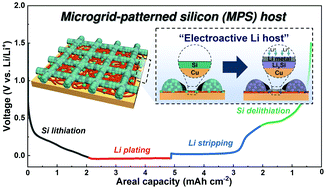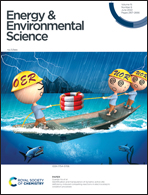A microgrid-patterned silicon electrode as an electroactive lithium host†
Abstract
Lithium (Li) hosts, which can electrochemically accommodate Li in preformed pores of three-dimensional frameworks, have been investigated as an advanced electrode architecture for high-energy-density Li-metal batteries. However, most of the previous studies on Li hosts utilized electrochemically inert materials for their framework constituents, resulting in undesired loss of gravimetric/volumetric energy densities of the resulting batteries. Here, we present an electroactive Li host based on a microgrid-patterned Si electrode (denoted as the MPS host). The MPS host is fabricated using a microscale direct ink writing technique. The lithiophilicity, electronic conductivity, and porous structure of the MPS host are customized to ensure the preferential direction of Li–ion flux and electron conduction into the ordered pore space, while providing the redox capacity. The resulting MPS host enables stepwise sequential Si lithiation/delithiation (from the Si in the microgrid frameworks) and Li plating/stripping (inside the pore space between the microgrids) reactions, verifying its unique behavior as an electroactive Li host. In addition, a full cell assembled with the MPS host and the LiNi0.8Co0.1Mn0.1O2 (NCM811) cathode (areal capacity = 3.8 mAh cm−2) exhibits high cell energy densities (644 Wh kgcell−1/1538 Wh Lcell−1) and reliable cyclability.



 Please wait while we load your content...
Please wait while we load your content...